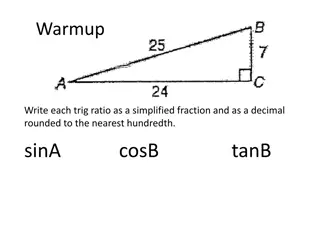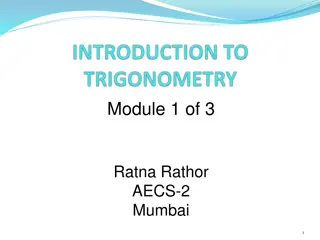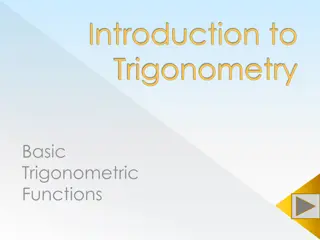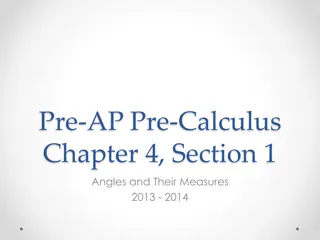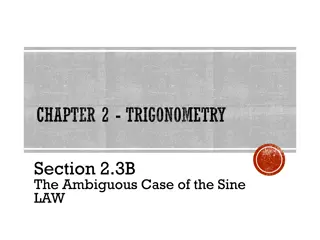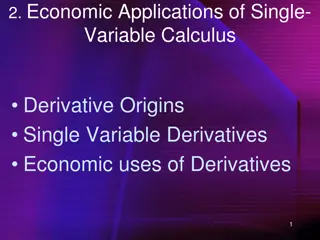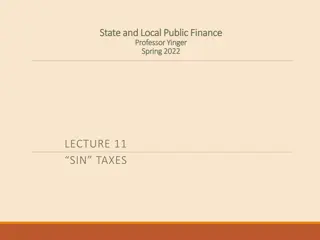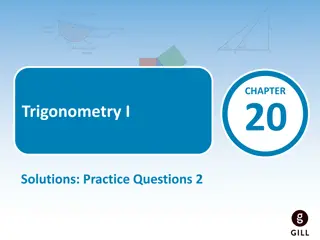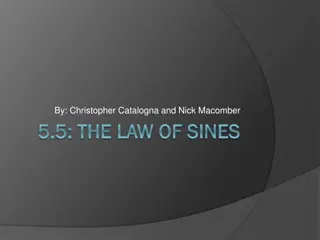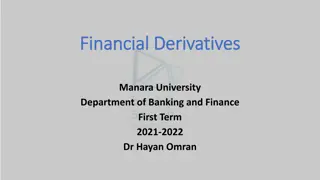Trigonometry Differentiation: Derivatives of Sin and Cos
Differentiation of sine and cosine functions from first principles, step-by-step. Understand how to find the derivatives of sin(x) and cos(x) using trigonometric principles. Detailed explanations and visual aids included.
Download Presentation

Please find below an Image/Link to download the presentation.
The content on the website is provided AS IS for your information and personal use only. It may not be sold, licensed, or shared on other websites without obtaining consent from the author.If you encounter any issues during the download, it is possible that the publisher has removed the file from their server.
You are allowed to download the files provided on this website for personal or commercial use, subject to the condition that they are used lawfully. All files are the property of their respective owners.
The content on the website is provided AS IS for your information and personal use only. It may not be sold, licensed, or shared on other websites without obtaining consent from the author.
E N D
Presentation Transcript
Trig differentiation Sin x cos x
Differentiation: Trigonometry & first principles BAT prove the derivatives of sin and cos from first principles KUS objectives Starter: differentiate one of these from first principles ? = 3? ? = 4? + 4 ? = ?2
Notes Differentiation from first principles This is a lowercase delta , representing a small increase in x ? ???? ?? ? ? ???? ?? ? ???????? = ?(? + ??) ?(?) ? + ?? ? ? ? + ?? ?(?) ?? ???????? = (x+ x, f(x+ x)) ???????? = (x, f(x)) ? ? + ?? ?(?) ?? ? (?) = lim ?? 0 Gradient = change in y change in x This is the definition for differentiating a function f(x+ x) f(x) We use h for ?? x+ x - x
y = x2 Example differentiation of y = x2 From first principles ? ? + ? ?(?) ?? ? (?) = lim ?? 0 (? + )2 ?2 ? + ?? ? Multiply the bracket ???????? = lim ?? 0 ?2+ 2( )(?) + ( )2 ?2 ? + ? Group some terms ???????? = lim ?? 0 2 ? + 2 Cancel h ???????? = lim ?? 0 At the original point, h = 0 ???????? = lim ?? 02? + ? (?) = ??
WB15a Derivative of sin x part 1 First principles ? ???(?) = ? ? + ? ? ? ? ??? ? 0 By the addition rule for sin(? + ?) ??? ? + ??? ? ??? 0 sin?cos + cos? sin sin? ??? 0 = Split up and rearrange sin? cos 1 ??? 0 cos? sin ??? 0 = + cos 1 ??? 0 sin ??? 0 = sin? + cos?
WB15b Derivative of sin x part 2 ? ?? cos 1 ??? 0 sin ??? 0 + cos? sin? = sin? As h 0 cos h 1 ??? 0 cos 1 = 0 = cos 1 0 0 As h 0 sin ??? 0 = = 1 ? = and sin approach each other and ? ??sin? = sin? ? + cos? ? sin 1 1 ? ?????? = ????
16a Derivative of cos x part 1 First principles ? ???(?) = ? ? + ? ? ? ? ??? ? 0 By the addition rule for cos(? + ?) ??? ? + ??? ? ??? 0 cos?cos sin? sin cos? ??? 0 = Split up and rearrange cos? cos 1 ??? 0 sin? sin ??? 0 = + cos 1 ??? 0 sin ??? 0 = cos? sin?
WB16b Derivative of cos x part 2 ? ?? cos 1 sin ??? 0 ??? 0 sin? cos? = cos? As h 0 cos h 1 ??? 0 cos 1 = 0 = cos 1 0 0 As h 0 sin ??? 0 = = 1 ? = and sin approach each other and ? ??cos? = cos? ? sin? ? sin ? ?????? = ???? 1 1
KUS objectives BAT prove the derivatives of sin and cos from first principles self-assess One thing learned is One thing to improve is
? ? + ?? ?(?) ?? You need to be able to differentiate Trigonometric Functions A ? (?) = lim ?? 0 Let f(x) = sinx (Angle x is in radians) ??? ? + ?? ???(?) ?? ? (?) = lim r ?? 0 Multiply the function using sin(A + B) x B r ????????? + ????????? ???? ?? O ? (?) = lim ?? 0 As x 0 Cos x 1 Sin x x ????(1) + ????(??) ???? ?? ? (?) = lim 1 2?2? ?? 0 Area of the sector OAB: Simplify terms ???? + ?????? ???? ?? 1 2?2???? Area of the triangle OAB: ? (?) = lim ?? 0 Sinx s cancel out As x approaches 0, the area of the triangle and sector become equal. Hence: 1 2?2???? =1 ?????? ?? ? (?) = lim ?? 0 2?2? Cancel x s ? ? = ???? ???? = ?
You need to be able to differentiate Trigonometric Functions Gradient = -1 y = Cos If: ? = ???? 1 y = Sin ?? ??= ???? Then: 0 /2 3 /2 2 -1 Gradient = 0 If: ? = ???? ? ?? ??= ? (?)????(?) This means that the Cos graph is actually telling you the gradient of the Sin graph at the equivalent point! Then: At , Cos = -1 The gradient of Sin at is -1 At 3 /2, Cos = 0 The gradient of Sin at 3 /2 is 0!
? ? + ?? ?(?) ?? You need to be able to differentiate Trigonometric Functions ? (?) = lim ?? 0 Let f(x) = cosx ??? ? + ?? ???(?) ?? ? (?) = lim ?? 0 Multiply the function using cos(A + B) ????????? ????????? ???? ?? ? (?) = lim ?? 0 As x 0 Cos x 1 Sin x x ???? 1 ????(??) ???? ?? ? (?) = lim ?? 0 Simplify terms ???? ?????? ???? ?? ? (?) = lim ?? 0 Cosx s cancel out ?????? ?? ? (?) = lim ?? 0 Cancel x s ? ? = ????



